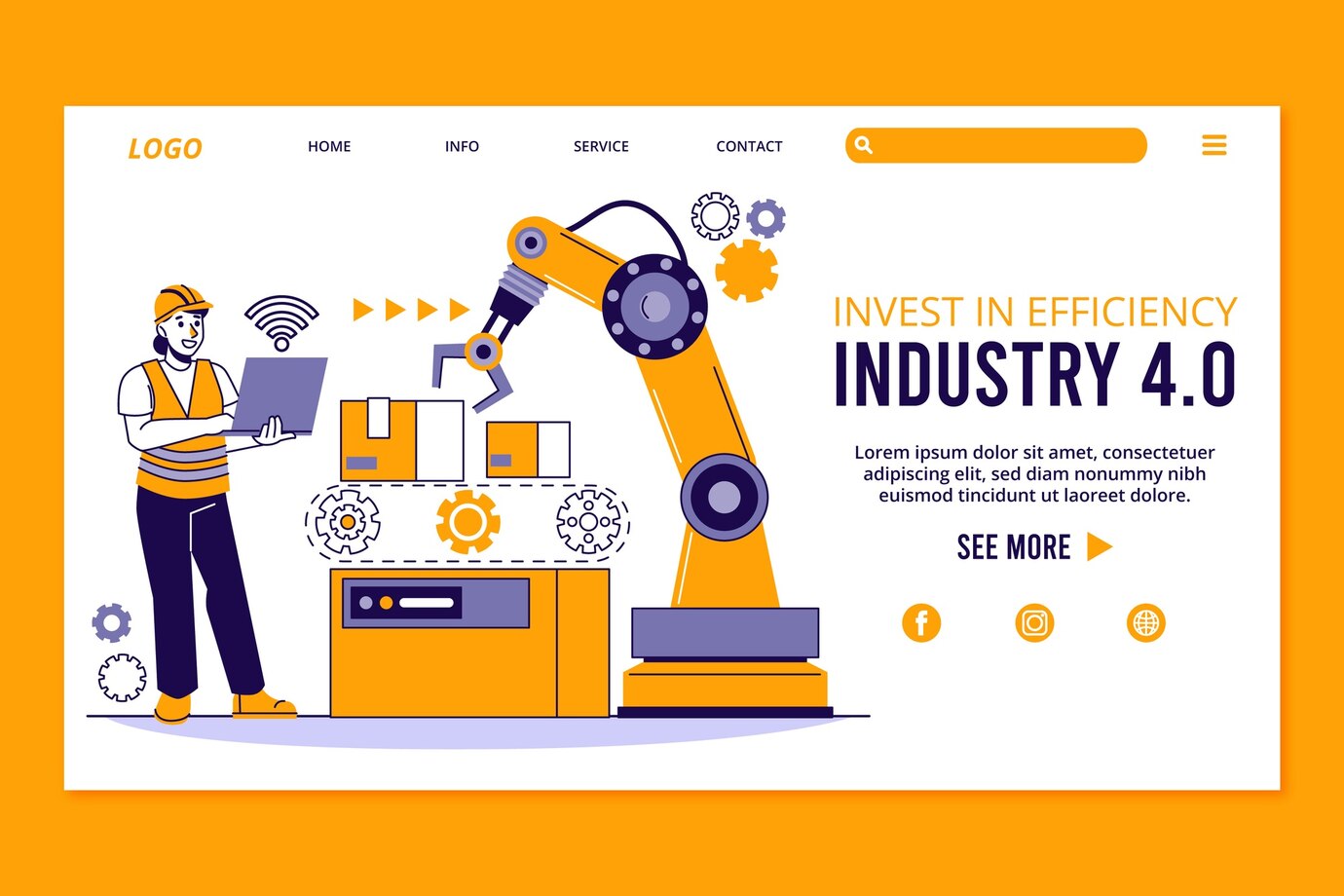Top 10 Expert Tips for Website Design for Manufacturing Companies
Introduction
Let’s face it: in today’s digital age, a business is only as strong as its online presence—no matter the industry. For manufacturing companies, a well-designed website isn’t just a luxury; it’s a necessity. Whether you’re a well-established factory or a start-up industrial company, having an effective website design can be the difference between attracting potential clients or getting lost in the digital noise.
If you’re asking yourself, “What makes the best website design for manufacturing companies?” then you’re in the right place. Let’s explore how a robust manufacturing web design can elevate your brand, engage potential customers, and boost your online visibility.
Why Website Design Matters for Manufacturing Companies
Imagine this: You’ve spent years perfecting your product, building a solid reputation in your industry, and delivering top-notch services. But when potential clients search online for your company, they’re greeted with a slow, outdated, or unprofessional website. Yikes! That’s a missed opportunity.

A well-designed manufacturing website isn’t just about looks—it’s about functionality, accessibility, and making the right impression. Here’s why the website design for manufacturing companies is crucial:
- First Impressions Matter: Visitors form opinions about your business in seconds. A modern, user-friendly website creates an immediate sense of trust and professionalism.
- It Reflects Your Business Identity: Your website should echo the values, products, and services of your manufacturing company. Whether you’re dealing in high-tech industrial machinery or consumer products, your website should tell your story in the most compelling way.
- Lead Generation & Conversions: Your website isn’t just a digital brochure—it’s a 24/7 sales tool. From clear calls to action to easy-to-navigate product catalogs, your website should encourage visitors to take action.
Essential Website Design Elements for Manufacturing Companies
| Category | Key Considerations | Best Practices | Examples |
|---|---|---|---|
| User Experience (UX) | – Simple, intuitive navigation – Mobile-friendly – Clear calls to action |
– Use easy-to-navigate menus – Ensure responsive design – Optimize for fast loading |
– Large, easy-to-click buttons – Minimalist design |
| Industry-Specific Visuals | – Showcase products and services – Use high-quality images/videos of manufacturing processes |
– Use professional images of facilities and products – Implement 360-degree product views |
– Hero images of machinery – Action shots of production lines |
| Content Strategy | – Provide detailed product information – Include case studies and client testimonials |
– Create product-specific landing pages – Include educational content like blogs, whitepapers |
– Product specification sheets – Success stories or testimonials |
| SEO & Performance | – Optimize for relevant industry keywords – Ensure fast loading times |
– Conduct keyword research for manufacturing-related terms – Optimize image sizes for speed |
– Fast load times – Keyword-focused content on product pages |
| E-commerce Integration | – If applicable, integrate e-commerce features – Ensure secure payment gateways |
– Offer online ordering systems – Include secure checkout process |
– B2B order systems – Payment gateway options |
| Branding & Trust | – Reflect company values and industry expertise – Highlight certifications and awards |
– Use trust signals like SSL, certifications, client logos – Maintain consistent branding throughout the site |
– Certification logos – Customer reviews and trust seals |
| Contact & Support | – Easy access to contact details – Multiple ways to reach support (chat, email, phone) |
– Include an FAQ section – Implement live chat for quick responses |
– Contact form – Live chat feature |
Key Features of a Great Manufacturing Website Design
When it comes to manufacturing web design, there are certain features that make a website stand out. Let’s break down the essentials that should be included in any manufacturing website design to ensure it works harder for your business.
1. Responsive Design:
In today’s world, users are browsing from all kinds of devices—smartphones, tablets, and desktops. A responsive design ensures that your site looks great and functions smoothly on any screen size.

Tip: If your site isn’t mobile-friendly, you’re missing out on a significant portion of potential clients. According to Statista, over 50% of web traffic worldwide comes from mobile devices!
2. Intuitive Navigation:
Clear navigation is a must. Your website’s structure should allow users to easily find what they’re looking for without frustration. Use simple categories and a clean layout to guide visitors to the right product, service, or contact information.
Example: For a manufacturing company, categories might include “Products,” “Services,” “Case Studies,” and “Contact Us.” Keep the navigation bar uncluttered, and avoid burying key information under too many sub-menus.
3. Compelling Visual Design:
The visual appeal of your website is the first thing people notice. This is where your brand’s personality should shine through. Use high-quality images of your factory, products, and people. Illustrate your capabilities, and build trust by showcasing your industry expertise.

Tip: A clean, professional design with modern typography and color schemes can elevate your company’s perceived credibility. Avoid overcrowding the page with too many elements.
4. SEO-Friendly Content:
SEO (Search Engine Optimization) is essential for ensuring your site shows up in search results. Optimizing your content with the right keywords will help your site rank higher and attract more organic traffic. Use phrases like “best website design for manufacturing company” and “industrial website design” in your copy, but be sure to do so naturally.
Tip: Incorporate industry-relevant terms like “industrial web design” and “factory website design” within headers, body text, and meta tags for maximum SEO effectiveness.
The Best Website Design Examples for Manufacturing Companies
Let’s take a look at some industrial website designs that shine in 2024. What makes them stand out, and how can you apply those same principles to your own site? Here are a few standout examples:
- Tesla Motors: Though primarily an electric vehicle company, Tesla’s website is a prime example of clean, sleek, and highly functional industrial web design. The focus on innovation and cutting-edge technology is evident in every aspect of the site.
- Caterpillar: Known for heavy machinery, Caterpillar’s website is optimized for easy navigation, showcasing their products with clear, high-quality images. Their customer-centric design speaks directly to their audience’s needs, with easy access to product specs, support, and purchasing options.
- John Deere: A classic in the agricultural and industrial sector, John Deere’s website uses a combination of rich imagery and straightforward navigation. Their site also includes case studies and a comprehensive support section, showing how their products solve real-world challenges.
Trends in Industrial Website Design for 2024
When it comes to industrial website design, it’s essential to stay ahead of the curve. Here are some key trends you should watch out for:
- Minimalist Design: A focus on clean layouts with a lot of white space makes for a more modern look.
- Bold Typography: Large, legible text that stands out can make your site easier to navigate and read, especially on mobile devices.
- Interactive Features: With the rise of augmented reality (AR), some industrial websites are now offering interactive product demos, allowing users to visualize products in their own environments.
- Video Content: Video continues to be a key trend in manufacturing website design. Whether it’s showcasing how your products are made or explaining your services, videos can drive engagement like no other medium.
Manufacturing Web Development: The Tech Behind the Design
While the aesthetic of your site is important, it’s just as essential to ensure that the back-end development supports your site’s functionality. Here’s what to consider when planning manufacturing web development:
- Content Management Systems (CMS): A user-friendly CMS, like WordPress or Joomla, can make managing your site a breeze. It allows you to update content without the need for technical expertise.
- E-Commerce Integration: If your manufacturing company sells products directly online, it’s essential to integrate an e-commerce system that’s secure, user-friendly, and reliable.
- Fast Loading Times: Website speed can make or break a user’s experience. Use optimized images, leverage caching, and keep your code streamlined to ensure your site loads quickly.
- Security Features: Manufacturing companies often deal with sensitive data. Protect your site and your customers by investing in SSL certificates and other security measures.
Conclusion
Building a successful website design for your manufacturing company is an investment that pays off in more ways than one. A well-crafted site with responsive design, easy navigation, and SEO-friendly content can elevate your brand, attract more leads, and improve your conversion rates.
Whether you’re updating an outdated site or creating one from scratch, focusing on modern industrial web design trends, incorporating high-quality visuals, and optimizing for mobile will put your business on the map.
Are you ready to make your website work harder for you? Start by evaluating your current site and consider how you can implement these tips.
Call-to-Action: Need help designing the perfect manufacturing website? Get in touch with our expert team today and let us create a website that drives results!

FAQs on Website Design for Manufacturing Companies
1. Why is website design important for manufacturing companies?
Answer:
A well-designed website helps manufacturing companies establish credibility, improve customer engagement, and streamline communication. It also enhances brand awareness, provides detailed product information, and can act as an effective lead-generation tool for attracting new clients and business opportunities.
2. What features should a manufacturing company’s website have?
Answer:
Key features for a manufacturing company’s website include:
- Clear product or service listings with specifications
- Easy-to-navigate menu structure
- Responsive design for mobile and desktop use
- Contact forms and support options
- Case studies or testimonials
- About us section detailing company history
- Integration with social media and e-commerce, if applicable
3. How does a good website design impact customer trust?
Answer:
A professional and well-structured website helps build trust by presenting the company as reliable and knowledgeable. When a website is easy to use, visually appealing, and contains accurate information, visitors are more likely to trust the company and consider doing business with them.
4. How can SEO improve my manufacturing website’s visibility?
Answer:
SEO (Search Engine Optimization) ensures that your website ranks well in search engine results, making it easier for potential clients to find you. By optimizing keywords related to your industry, product descriptions, and using local SEO practices, your website can drive organic traffic and attract more leads.
5. Is it necessary to have e-commerce functionality on a manufacturing company’s website?
Answer:
While not essential for every manufacturing company, e-commerce functionality can be very beneficial if your business sells products directly online. It allows customers to place orders, access product catalogs, and make purchases, streamlining the buying process.
6. How much should I budget for designing a website for my manufacturing company?
Answer:
The cost of website design varies depending on factors like complexity, functionality, and the design company you choose. Basic websites may start at a few thousand dollars, while more complex, custom websites could cost tens of thousands of dollars. It’s important to set a budget based on your needs and expectations.
7. What is responsive design, and why is it important for my website?
Answer:
Responsive design ensures that your website adapts to different screen sizes and devices, including smartphones, tablets, and desktops. Given the increase in mobile browsing, responsive design is crucial for providing an optimal user experience across all platforms.
8. Can I update my manufacturing website myself after it’s designed?
Answer:
Yes, many website designs offer content management systems (CMS) like WordPress, Wix, or Shopify that allow you to update text, images, and other content easily. However, some complex custom-built websites may require a developer for updates and maintenance.
9. How do I improve website loading speed for my manufacturing website?
Answer:
To improve your website’s loading speed, you can:
- Optimize images and use compressed files
- Minimize the use of heavy scripts
- Enable browser caching
- Use content delivery networks (CDNs) to speed up global delivery
- Choose a reliable hosting provider
10. How can my manufacturing website generate leads?
Answer:
Your website can generate leads by:
- Offering valuable content (eBooks, white papers, industry reports)
- Creating clear calls-to-action (CTAs) like “Get a Quote” or “Contact Us”
- Integrating contact forms for easy inquiries
- Showcasing customer testimonials or case studies to build credibility
- Running targeted ads to drive traffic to lead-generation pages



